Revitalization in the third world: Rose Town, Jamaica explores healing through restoration

Posted October 7, 2009 at 1:24PM
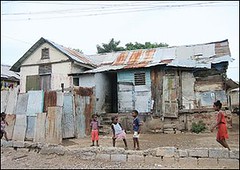

A great story is emerging in Rose Town, Jamaica, a community in the process of being reborn with the help of HRH the Prince of Wales and The Prince's Foundation for the Built Environment.
My very favorite writings here involve the revitalization of distressed communities, when done in an inclusive, sustainable fashion. Whether in St. Louis, Cincinnati, Houston, Los Angeles, Boston, Atlanta, Milwaukee, or elsewhere (and I've written about all of those), the people in these places are giving us amazing energy, creativity, and shining examples of how to build and strengthen neighborhoods in ways that form the antithesis of sprawl. Rose Town brings us another such story, in a community that in some ways has been even more severely in need.
Rose Town, according to my friend Hank Dittmar, who heads The Prince's Foundation, is the ghetto in Kingston next to Trenchtown, which of course gave us Bob Marley. One of the poorest districts in a poor country, Rose Town has witnessed pronounced hardship, including devastating gang warfare between its northern and southern sectors that led to the abandonment of houses and the demolition of buildings and roads. This turmoil created a substantial vacated area that, along with an underbuilt portion of the community, has become the focus of the reconstruction efforts.
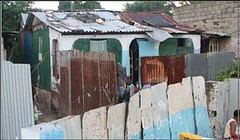

Working with the Rose Town Benevolent Society and other local partners, the Prince's Foundation is "rehabilitating existing housing and will build new affordable housing units, which reflect the local vernacular style and are suited to prevailing climatic conditions and the traditional way of life; over time we hope that these will prove to be exemplars for projects elsewhere in Jamaica. In addition, we have begun and will continue to improve infrastructure, provide other amenities for the community, establish a skills training program and create employment opportunities." The idea is to help heal the community's social rifts by rebuilding it with participation by all. Pretty commendable, if you ask me.
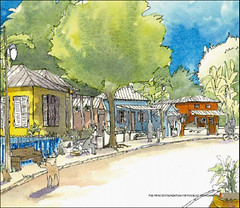 One of the aspects I like best is how much the rebuilding is respecting local conditions, tradition and culture (unlike, say, this place). This is in no small part due to the Foundation's strong commitment to involving residents in extensive architectural and planning charrettes, led by the wizardry of Duany/Plater-Zyberk and other experts. A comprehensive report on the 2008 charrette, which produced most of the designs accompanying this post (note especially the before-and-afters), makes excellent reading on these topics.
One of the aspects I like best is how much the rebuilding is respecting local conditions, tradition and culture (unlike, say, this place). This is in no small part due to the Foundation's strong commitment to involving residents in extensive architectural and planning charrettes, led by the wizardry of Duany/Plater-Zyberk and other experts. A comprehensive report on the 2008 charrette, which produced most of the designs accompanying this post (note especially the before-and-afters), makes excellent reading on these topics.
On its website, The Foundation is cautious but encouraged in its report of the progress so far in Rose Town:
"While much remains to be done, we are pleased with the progress that has been made so far, thanks to the efforts of our local partners, particularly the Rose Town Benevolent Society. There is a now a greater sense of community and a willingness to work together. Improvements to the local environment, coupled with the establishment of the [new] library and community centre, have contributed to a tidier Rose Town with a renewed sense of pride . . .
"An Architectural Charrette in 2008 demonstrated ways in which local vernacular styles can be used in Rose Town and how it is possible to develop appropriate unit types which are suited to local conditions and which reflect the community's wishes and respect its culture and traditions. The Charrette built upon the conclusions of the 2006 Enquiry by Design (EbD), which The Prince's Foundation led with Duany Plater-Zyberk . . . It is an affirmation of our belief in the vital role of the community and locally inspired solutions in creating sustainable settlements."
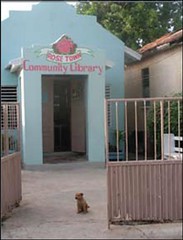 The 2006 charrette led to the creation of a master plan for the community, creating a neighborhood center in what was formally called "no-man's-land" separating the sharply divided community. It also provides for public space, civic buildings and amenities intended to help mend the fractured ties between the north and south of Rose Town. The 2008 charrette focused on designing appropriate housing types to fit into this master plan.
The 2006 charrette led to the creation of a master plan for the community, creating a neighborhood center in what was formally called "no-man's-land" separating the sharply divided community. It also provides for public space, civic buildings and amenities intended to help mend the fractured ties between the north and south of Rose Town. The 2008 charrette focused on designing appropriate housing types to fit into this master plan.
The report includes a nice section on best practices, written by American green architect Steve Mouzon, presenting appropriate building design and construction techniques for local conditions. Although not labeled as such, the section really can be read as sustainability guidance, recommending the use of natural, locally sourced materials and building methods that avoid the floodplain and take advantage of passive cooling design for Jamaica's hot weather. There's also a section on wetlands and floodplain management, proposing catchment areas that can be used for recreation when dry.
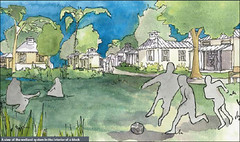 These practices could create a sort of "green jobs" program for Rose Town, especially since the Foundation began a Jamaican construction skills training program to help young people learn the craft of building and restoring houses in Rose Town. This included a nine-week training session in construction and restoration. Beyond the buildings per se, a team from The Prince's School of Traditional Arts (PSTA) followed up with a visit earlier this year "to meet the local people and assess the potential for starting up [another] education program focusing on design and product development for the commercialization of products by local craftsmen and artisans."
These practices could create a sort of "green jobs" program for Rose Town, especially since the Foundation began a Jamaican construction skills training program to help young people learn the craft of building and restoring houses in Rose Town. This included a nine-week training session in construction and restoration. Beyond the buildings per se, a team from The Prince's School of Traditional Arts (PSTA) followed up with a visit earlier this year "to meet the local people and assess the potential for starting up [another] education program focusing on design and product development for the commercialization of products by local craftsmen and artisans."
There's lots, lots more on the Foundation's website and associated links and, of course, in the report of the architectural charrette. Hank Dittmar also can walk you through a short slide show explaining some of the nuances beyond what I could capture here:
All images are courtesy of The Prince's Foundation for the Built Environment. Most can be accessed here.